Generative Predictive Conversational AI A Comprehensive Comparison

Artificial intelligence is revolutionizing the way you engage with technology and businesses. When comparing generative AI vs predictive AI vs conversational AI, each serves a distinct purpose. Generative AI produces content such as text, images, or audio, while predictive AI analyzes data to predict outcomes. Conversational AI facilitates human-like communication through chatbots and voice assistants. In customer service, generative AI delivers personalized responses, predictive AI anticipates customer needs, and conversational AI ensures smooth interactions. Sobot seamlessly integrates these technologies into its AI-powered solutions, boosting customer satisfaction and operational efficiency. This powerful combination meets modern demands, making your customer interactions smarter and more impactful.
What is Generative AI?
Definition and Core Functionality
Generative AI refers to a type of artificial intelligence that creates original content, such as text, images, or even music, based on user prompts. It relies on deep learning models, which mimic human learning and decision-making processes. These models analyze vast amounts of data to identify patterns and generate outputs that feel human-like. For example, when you ask a chatbot a question, generative AI crafts a response tailored to your query.
Researchers and industries use generative AI to enhance creativity and efficiency. It supports various stages of research, including discovery, understanding, and creation. This technology also establishes cultural norms and perspectives, making it a valuable tool for academic and professional applications.
Key Features of Generative AI
Generative AI stands out due to its ability to produce high-quality, context-aware content. Its key features include:
- Adaptability: It can generate outputs across multiple formats, such as text, images, and videos.
- Personalization: It tailors responses based on user inputs, ensuring relevance.
- Efficiency: It accelerates processes like content creation and problem-solving.
- Scalability: It handles large-scale tasks, such as analyzing extensive datasets or generating multiple outputs simultaneously.
Quantitative benchmarks highlight its effectiveness. For instance, enterprises adopting generative AI report a 55% increase in productivity and a 27% reduction in costs. Additionally, the technology improves quality by 41%, as shown in the chart below:
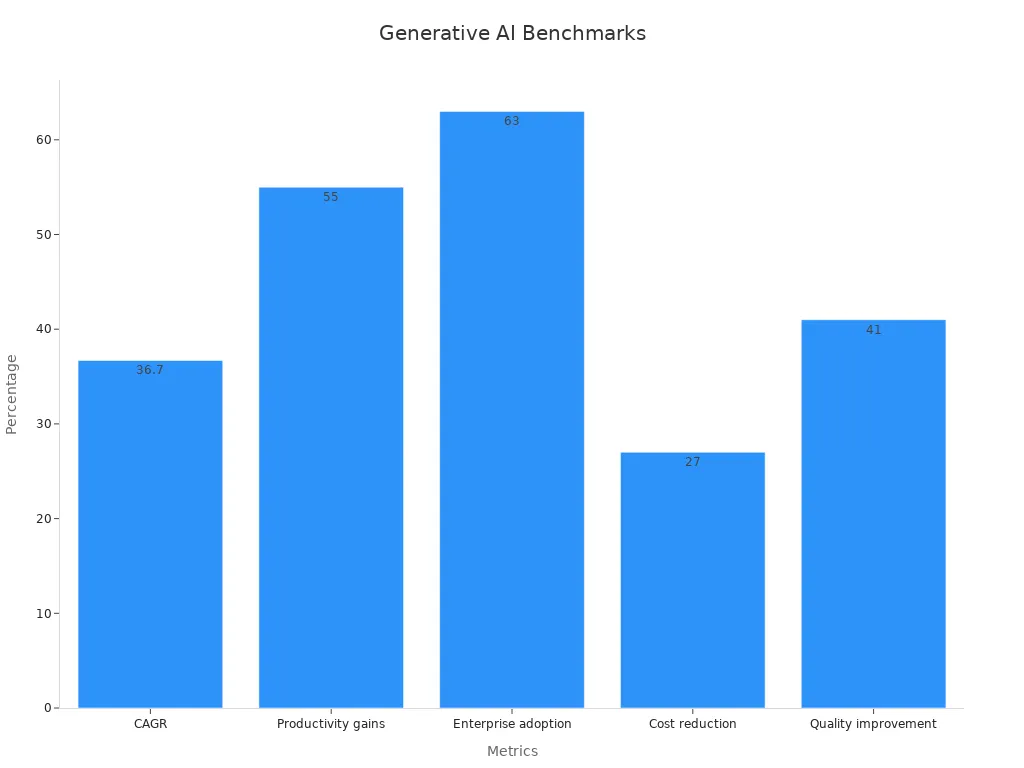
Applications in Customer Service
Generative AI transforms customer service by automating interactions and enhancing user experiences. It powers chatbots, virtual assistants, and other tools that provide instant, accurate responses. For example, H&M uses generative AI to operate a virtual shopping assistant, reducing response times by 70%. Similarly, JetBlue implemented AI-driven chat automation, saving 73,000 hours of agent time in just one quarter.
This technology also personalizes customer interactions. Retailers like H&M and electronics companies integrate generative AI into their systems to suggest products, answer queries, and improve satisfaction rates. These applications not only streamline operations but also boost customer loyalty.
| Company | Implementation Description | Results |
|---|---|---|
| H&M | AI-powered virtual shopping assistant reducing response times. | 70% reduction in response times compared to human agents. |
| JetBlue | Implemented LLM solution in contact center for chat automation. | Saved 280 seconds per interaction, totaling 73,000 hours of agent time saved in a quarter. |
Generative AI continues to redefine how businesses interact with customers, making services faster, smarter, and more efficient.
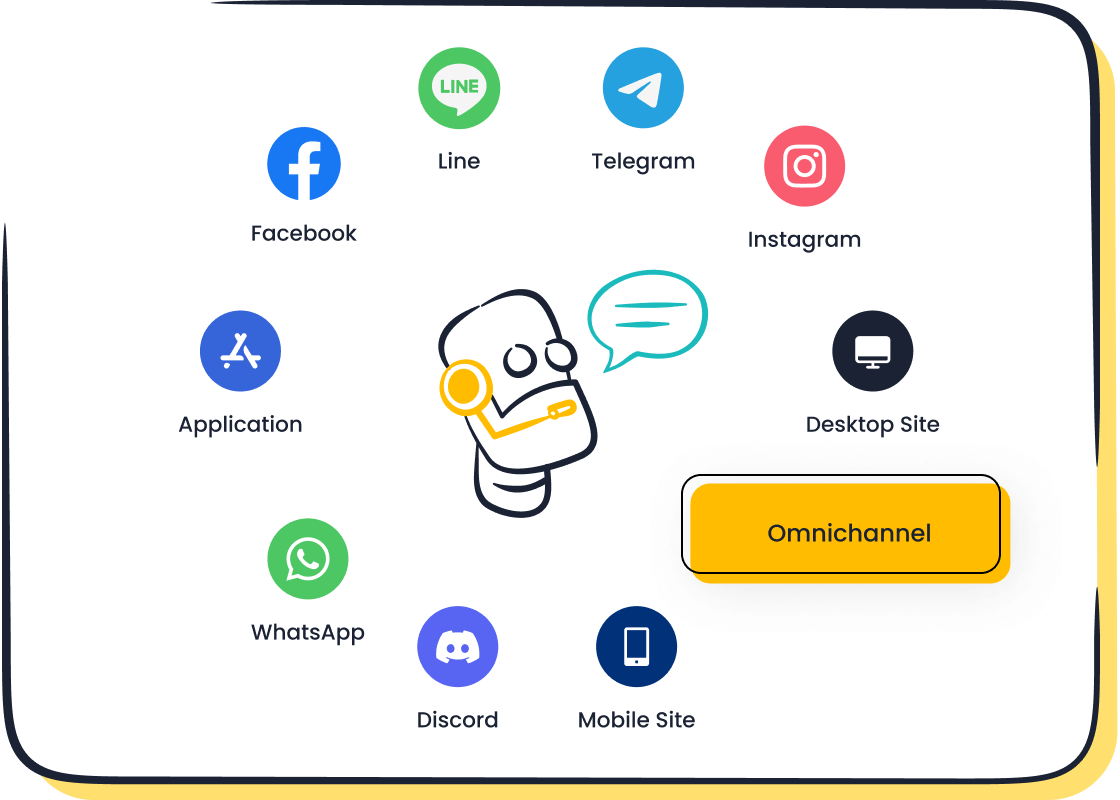
How Sobot AI Chatbot Utilizes Generative AI
Sobot AI Chatbot harnesses the power of generative AI to redefine how you interact with businesses. By using advanced language models, it creates human-like responses that feel natural and engaging. This capability allows the chatbot to handle complex queries, provide accurate answers, and deliver personalized experiences.
One of the standout features of Sobot's chatbot is its ability to operate 24/7. It uses generative AI to autonomously resolve common questions, reducing the need for human agents. For example, if you ask about product availability or shipping details, the chatbot instantly generates a relevant response. This efficiency not only saves time but also ensures you receive consistent support.
The chatbot also excels in improving customer satisfaction. It achieves this by analyzing your input and tailoring its replies to match your intent. This personalized approach has led to impressive results, as shown in the table below:
| Metric Description | Value |
|---|---|
| Reduction in inbound discussion volume | 20% |
| Positive feedback rate | 96%+ |
| Correct answers provided by AI | 80% |
| Customer satisfaction rate | 95% |
| Self-service question resolution | 22.2% |
| Customer satisfaction score (CSAT) | 97% |
| Problems solved with AI assistance | 85% |
| Customer happiness rate | 99% |
| Increase in sign-off rate | 35% |
| Increase in COD collection rate | 40% |
The chatbot's ability to generate accurate and context-aware responses has a direct impact on customer happiness. For instance, it resolves 85% of problems with minimal human intervention. This efficiency translates into a 99% customer happiness rate, making it a reliable tool for businesses.
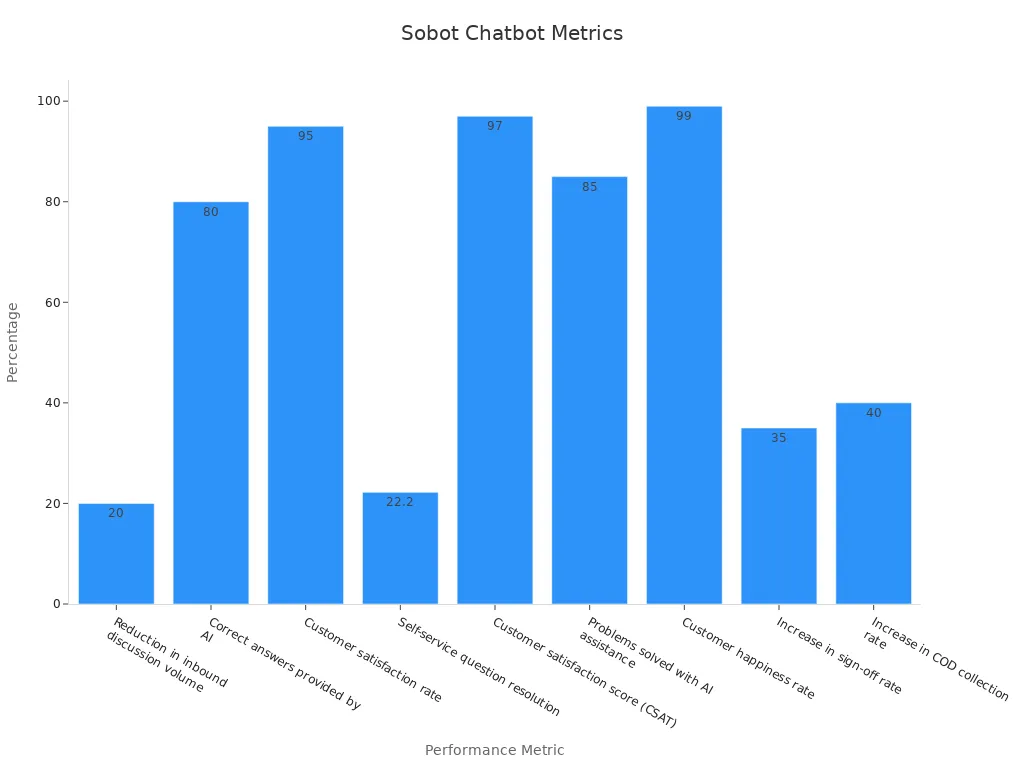
Sobot AI Chatbot also supports multiple languages, ensuring you can communicate in your preferred language. Its omnichannel capabilities allow seamless interaction across platforms like WhatsApp, SMS, and live chat. This flexibility makes it an ideal solution for businesses aiming to enhance customer engagement.
By leveraging generative AI, Sobot's chatbot not only improves efficiency but also reduces costs. It handles repetitive tasks, freeing agents to focus on complex issues. This combination of automation and personalization ensures you receive exceptional service every time.
What is Predictive AI?
Definition and How It Works
Predictive AI uses artificial intelligence to analyze historical data and forecast future outcomes. It relies on advanced algorithms and machine learning models to identify patterns and trends. By processing large datasets, it provides insights that help businesses make informed decisions. Predictive AI automates tasks like data collection and cleansing, ensuring accuracy and efficiency. For example, it can predict customer behavior, enabling you to anticipate needs and improve service delivery.
This type of AI works by combining data analysis with predictive modeling. It uses statistical techniques to evaluate past events and estimate future possibilities. Predictive AI enhances operational efficiency by offering actionable insights. It empowers you to address potential challenges before they arise, making it a valuable tool for businesses.
Common Standards and Techniques
Predictive AI employs several techniques to deliver accurate forecasts. These include:
- Machine Learning Models: Algorithms like decision trees and neural networks analyze data to predict outcomes.
- Predictive Analytics: This approach uses statistical methods to uncover trends and patterns.
- Data Integration: Predictive AI combines information from multiple sources to create a unified dataset.
- Automation: It streamlines processes like data cleansing and preparation, ensuring reliable results.
These techniques allow predictive AI to provide precise and actionable insights. Businesses use these insights to optimize operations and enhance customer experiences.
Use Cases in Customer Support
Predictive AI plays a crucial role in customer service by improving efficiency and satisfaction. It helps you anticipate customer needs and resolve issues proactively. For instance, Delta Airlines uses predictive AI to analyze customer data and predict potential service problems. This strategy has increased customer satisfaction by 12% and reduced complaints by 10%.
Another example is AT&T, which implemented AI-powered chatbots to handle customer inquiries. These chatbots resolved 80% of inquiries without human intervention. This approach reduced operational costs by 25% and increased customer satisfaction by 15%.
| Company | Strategy | Result |
|---|---|---|
| Delta Airlines | Uses AI to analyze customer data and predict potential service issues. | 12% increase in customer satisfaction and 10% reduction in service-related complaints. |
| AT&T | Implemented AI-powered chatbots for customer inquiries. | 80% of inquiries resolved without human intervention, 25% reduction in operational costs, and 15% increase in customer satisfaction. |
Predictive AI transforms customer service by enabling faster responses and better problem-solving. It ensures you can deliver personalized and efficient support, enhancing overall customer satisfaction.
Predictive AI in Sobot's Contact Center Solutions
Predictive AI plays a transformative role in Sobot's contact center solutions. It empowers you to anticipate customer needs, streamline operations, and deliver proactive support. By analyzing historical data, predictive AI identifies patterns and trends, enabling you to make informed decisions and improve service quality.
Sobot integrates predictive AI into its platform to enhance customer interactions. For example, the system can forecast peak inquiry times, allowing you to allocate resources effectively. This ensures shorter wait times and higher customer satisfaction. Predictive AI also helps you identify potential issues before they escalate. If a product frequently generates complaints, the system alerts your team to address the problem proactively.
One of the standout features of Sobot's predictive AI is its ability to optimize agent performance. It analyzes past interactions to recommend the best responses for specific scenarios. This reduces resolution times and improves accuracy. Additionally, predictive AI supports personalized customer experiences. By understanding user behavior, it suggests tailored solutions, increasing the likelihood of positive outcomes.
Sobot's predictive AI also excels in sales and marketing. It identifies high-value leads by analyzing customer data, helping you focus on prospects most likely to convert. This targeted approach boosts efficiency and revenue. For instance, businesses using Sobot's predictive AI have reported a 30% increase in sales conversions.
The platform's predictive capabilities extend to operational efficiency. It automates repetitive tasks like data analysis, freeing your team to focus on complex challenges. With predictive AI, you gain actionable insights that drive better decision-making and long-term success.
By leveraging predictive AI, Sobot ensures your contact center operates at peak efficiency. It empowers you to deliver exceptional service, improve customer loyalty, and achieve measurable results.
What is Conversational AI?
Definition and Purpose
Conversational AI refers to technology that enables machines to engage in human-like communication. It uses advanced techniques like natural language processing (NLP) and machine learning to understand, process, and respond to user inputs. Unlike traditional systems, conversational AI adapts to context, making interactions more intuitive and meaningful. Its primary purpose is to facilitate seamless communication between humans and machines, whether through text-based chatbots or voice assistants.
The conversational AI market is growing rapidly, projected to reach $32.62 billion by 2030. This growth reflects the increasing demand for AI-powered solutions that enhance efficiency and improve user experiences. For example, 81% of HR leaders have adopted AI to streamline operations, while businesses report a 14% improvement in issue resolution per hour. These advancements highlight the transformative potential of conversational AI in various industries.
How Conversational AI Enhances Interactions
Conversational AI improves interactions by making them faster, more accurate, and user-friendly. It uses NLP to interpret user intent and provide relevant responses. This technology also learns from past interactions, ensuring continuous improvement. For instance, chatbots can handle straightforward questions, while voice assistants manage complex tasks like scheduling or navigation.
Statistics show that 74% of internet users prefer chatbots for simple queries, while 64% value their 24/7 availability. Additionally, 69% of consumers report satisfaction with their last chatbot interaction. These figures demonstrate how conversational AI meets user expectations by offering convenience and reliability.
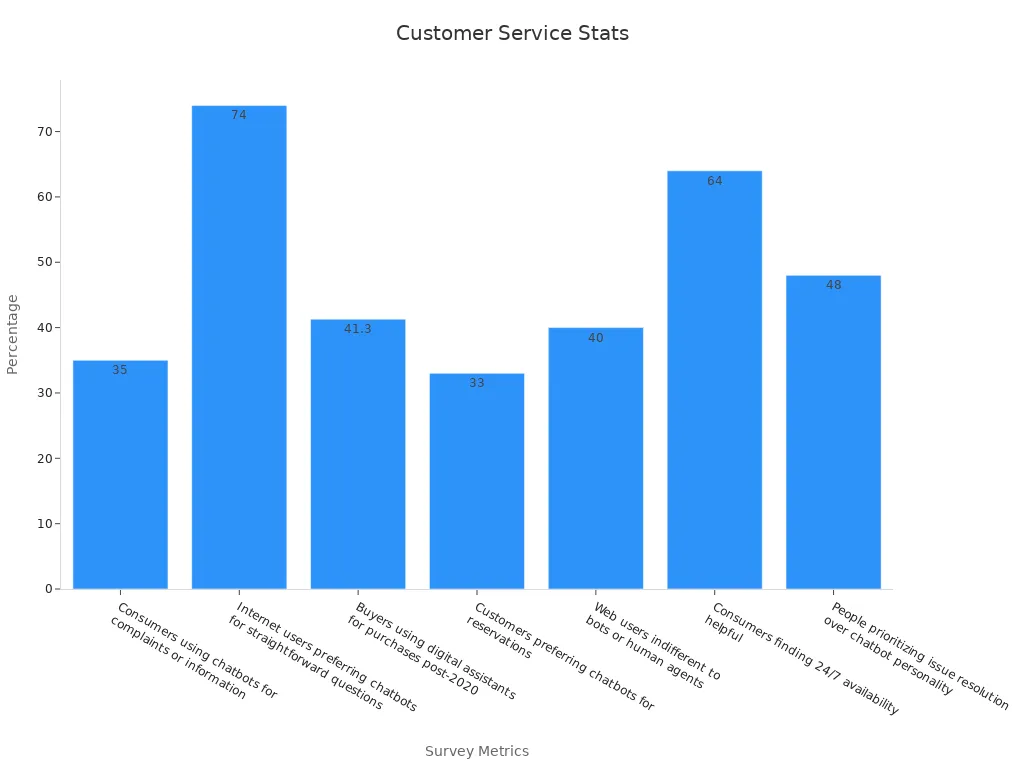
Applications in Customer Service Centers
Conversational AI has revolutionized customer service centers by automating routine tasks and enhancing user experiences. Nearly 50% of support units have adopted this technology, with 44% planning to do so. Popular applications include routing requests, analyzing feedback, and providing self-service tools. For example, Vodafone uses AI chatbots to manage inquiries, allowing teams to focus on complex issues. Similarly, Sephora's virtual assistant helps customers discover products and book services.
The benefits extend beyond automation. Conversational AI reduces costs, improves productivity, and boosts satisfaction. Businesses report a 94% increase in productivity and a 65% reduction in costs after implementing AI solutions. These results underscore the value of conversational AI in creating efficient and customer-centric service environments.
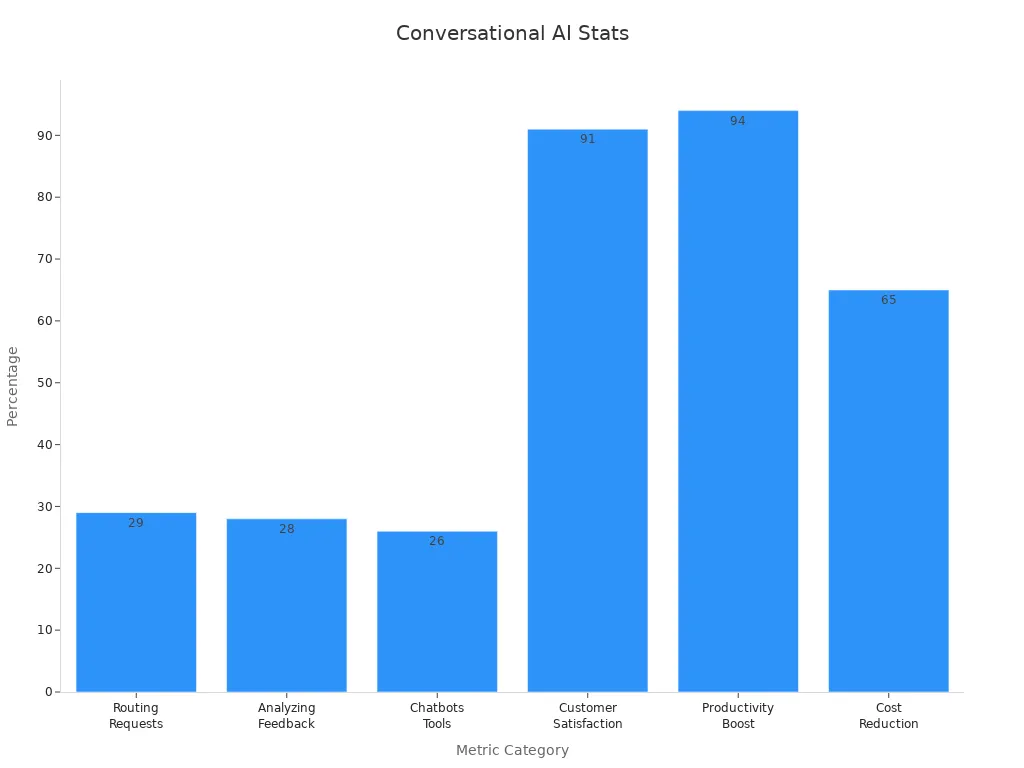
Sobot AI Chatbot as a Conversational AI Tool
Sobot AI Chatbot stands out as a powerful conversational AI tool designed to transform how you interact with businesses. By combining advanced natural language processing (NLP) and large language models (LLMs), it delivers human-like communication that feels intuitive and engaging. Whether you’re asking about product details or troubleshooting an issue, the chatbot ensures accurate and context-aware responses.
One of the chatbot’s key strengths lies in its ease of deployment. Unlike many providers that require a technical team for setup, Sobot AI Chatbot offers an out-of-the-box solution. You can configure it without writing a single line of code. This simplicity allows businesses to get started quickly, saving time and resources.
The chatbot also excels in learning and adapting. It uses self-developed NLP and advanced LLMs to continuously improve its accuracy. For example, if you frequently ask about shipping policies, the chatbot refines its responses to provide faster and more precise answers. This intelligence ensures that your interactions remain relevant and efficient.
Here’s a comparison of Sobot AI Chatbot with ordinary providers:
| Feature | Ordinary Providers | Sobot AI Chatbot |
|---|---|---|
| Deployment | Difficult without a technical team | Out of the box, no code required |
| Training | Unknown strategies to train | Assisted by professional technical teams |
| Intelligence | Limited learning capabilities | Self-developed NLP and advanced LLM |
Sobot AI Chatbot’s conversational AI capabilities extend across multiple channels, including WhatsApp, SMS, and live chat. This omnichannel support ensures you can engage with businesses on your preferred platform. Additionally, the chatbot operates 24/7, providing uninterrupted assistance. Its ability to handle repetitive queries autonomously reduces the workload on human agents, allowing them to focus on complex issues.
By leveraging conversational AI, Sobot AI Chatbot not only enhances customer satisfaction but also drives operational efficiency. Its intelligent design ensures that every interaction feels seamless, making it an indispensable tool for modern businesses.
Generative AI vs Predictive AI vs Conversational AI

Key Differences in Functionality
Understanding the differences between generative AI, predictive AI, and conversational AI helps you choose the right tool for your needs. Each type of AI serves a unique purpose and operates differently.
- Generative AI focuses on creating new content, such as text, images, or music. It uses advanced deep learning techniques like GANs (Generative Adversarial Networks) to produce outputs that feel original and human-like. For example, it can generate product descriptions or marketing visuals tailored to your brand.
- Predictive AI analyzes historical data to forecast future outcomes. It employs statistical algorithms and machine learning models to identify patterns and trends. This makes it ideal for predicting customer behavior or identifying potential issues before they arise.
- Conversational AI enables machines to engage in human-like communication. It uses natural language processing (NLP) to understand and respond to user inputs. This technology powers chatbots and virtual assistants, ensuring smooth and intuitive interactions.
Here’s a detailed comparison of their functionalities:
| Feature | Generative AI | Predictive AI |
|---|---|---|
| Goal | Generates new and individual works (e.g., images, music, text) | Detects patterns to predict future occurrences (e.g., customer behavior) |
| Output | Produces completely new data or information | Provides forecasts based on historical data |
| Data Input | Works with large, diverse datasets (e.g., images, text, audio) | Uses smaller, focused datasets for specific predictions |
| Methods | Utilizes complex algorithms like GANs and VAEs | Employs statistical techniques like regression and classification |
| Evaluation | Based on subjective parameters (e.g., creativity, originality) | Uses numerical metrics (e.g., accuracy, precision) |
| Interpretability | Often obscure, leading to mistrust | Generally interpretable, showing relationships between data and predictions |
| Applications | Content creation, drug discovery, material science | Finance, healthcare, marketing campaigns |
These distinctions highlight how each AI type excels in specific areas. Generative AI thrives in creative tasks, predictive AI shines in data-driven decision-making, and conversational AI bridges the gap between humans and machines.
Overlaps and Complementary Use Cases
While generative AI, predictive AI, and conversational AI have distinct functionalities, they often overlap in real-world applications. Combining their strengths can create powerful solutions for customer service.
For instance, a retail giant might use predictive AI to analyze customer data and forecast shopping trends. Generative AI could then create personalized marketing content based on these insights. Conversational AI would handle customer interactions, answering questions and guiding users through their shopping journey.
Here are some examples of complementary use cases:
| Use Case | Description |
|---|---|
| Retail advisor training | A beauty retailer uses an AI Agent as a virtual beauty advisor to onboard and train store associates, enhancing product knowledge and customer service. |
| Product discovery and assistance | A retail giant deploys AI Agents to assist customers from product discovery to post-purchase support, providing tailored assistance through a natural language interface. |
| Gift finder experience | A retailer pilots an AI Agent for personalized gift recommendations, analyzing customer interactions and preferences to suggest ideal products. |
| Customer service AI Agent | A solutions provider uses AI Agents to assist human agents by automating tasks and streamlining workflows in call centers. |
| Insurance loan AI sales Agent | A bank employs outbound voice AI Agents to re-engage customers who abandoned transactions, using personalized insights to increase conversions. |
These examples show how integrating multiple AI types can enhance customer experiences. Predictive AI identifies opportunities, generative AI creates engaging content, and conversational AI ensures seamless communication.
Choosing the Right AI for Customer Service Needs
Selecting the right AI for your customer service depends on your goals and challenges. Each AI type offers unique benefits, so understanding your priorities is essential.
To make an informed decision, consider these steps:
- Establish Clear Criteria: Define measurable aspects like cost, usability, and support.
- Prioritize Your Criteria: Focus on what matters most to your objectives, such as improving response times or reducing costs.
- Choose a Relevant Baseline: Compare AI options against a standard to evaluate their effectiveness.
- Be Objective in Scoring: Use data to minimize bias when assessing alternatives.
- Foster Team Collaboration: Involve stakeholders to ensure the chosen solution aligns with your needs.
- Review and Analyze Results: Examine scores to identify the best fit for your priorities.
For example, if your goal is to improve customer engagement, conversational AI might be the best choice. If you want to predict customer behavior, predictive AI would be more suitable. Generative AI works well for creating personalized content or automating creative tasks.
The PEAK Matrix® provides a helpful framework for evaluating AI service providers. It categorizes them into Leaders, Major Contenders, and Aspirants based on their capabilities and market impact. This analysis helps you identify providers that align with your goals.
By carefully evaluating your needs and the strengths of each AI type, you can implement a solution that enhances customer satisfaction and operational efficiency.
The Role of AI in Transforming Customer Service
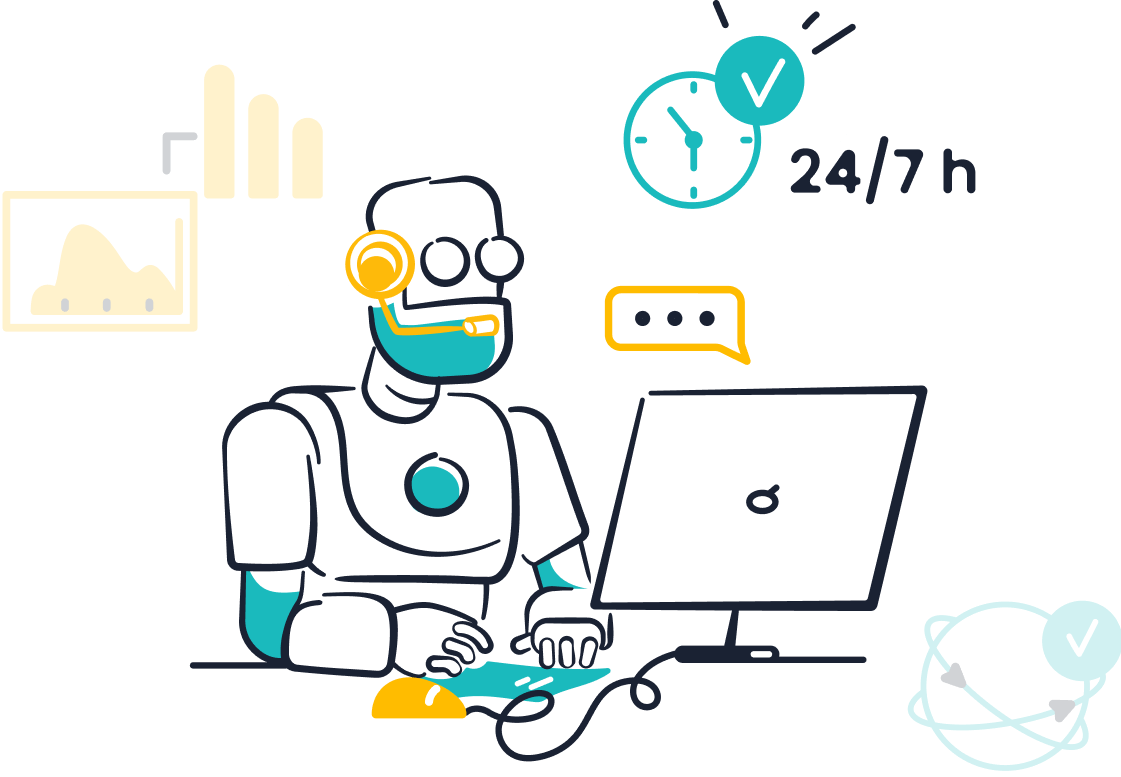
How AI Improves Customer Experience
AI has revolutionized customer service by enhancing how businesses interact with their customers. It uses technologies like big data analytics, recommendation systems, and conversational agents to deliver personalized and efficient experiences. For example, AI-powered chatbots can instantly answer questions, reducing wait times and improving satisfaction. These tools also analyze customer data to predict needs, ensuring proactive support.
Metrics like the Customer Satisfaction Score (CSAT) and Net Promoter Score (NPS) highlight the impact of AI on customer experience. CSAT measures how satisfied users feel after interacting with a service, while NPS gauges their loyalty and likelihood of recommending the service. Studies show that 75% of consumers are willing to spend more on businesses that provide excellent customer experiences. Additionally, over 60% of customer experience managers report prioritizing customer satisfaction more than in previous years.
Sobot integrates AI into its solutions to improve customer interaction. Its AI-powered chatbot operates 24/7, providing instant responses and reducing the workload on human agents. By analyzing customer data, Sobot ensures personalized interactions, making every experience seamless and efficient.
Benefits of Combining Generative, Predictive, and Conversational AI
When you combine generative, predictive, and conversational AI, the results are transformative. Each type of AI brings unique strengths to the table, and together, they create a powerful synergy. Generative AI produces personalized content, predictive AI anticipates customer needs, and conversational AI ensures smooth communication. This combination enhances customer interaction and operational efficiency.
For instance, a retail business might use predictive AI to analyze shopping trends and generative AI to create tailored marketing content. Conversational AI can then guide customers through their shopping journey, answering questions and offering recommendations. This integrated approach not only improves satisfaction but also boosts sales and loyalty.
Sobot exemplifies the benefits of combining these AI technologies. Its chatbot uses generative AI to craft human-like responses, predictive AI to anticipate customer queries, and conversational AI to facilitate natural interactions. This comprehensive solution helps businesses reduce costs, improve efficiency, and deliver exceptional customer service.
Sobot's Vision for the Future of AI in Customer Support
Sobot envisions a future where AI transforms customer service into a seamless and personalized experience. By 2028, experts predict AI technologies will reshape how businesses interact with their customers. Sobot aims to lead this transformation by integrating advanced AI capabilities into its solutions.
Generative AI will play a key role in creating personalized content for marketing and support. Predictive AI will enable businesses to make data-driven decisions, identifying trends and addressing issues before they arise. Conversational AI will ensure every interaction feels natural and engaging, fostering stronger customer relationships.
Sobot's commitment to innovation and customer-centricity drives its vision. By leveraging AI, Sobot plans to enhance client interactions, streamline processes, and improve satisfaction. Its solutions will empower businesses to deliver exceptional service, setting new standards in customer support.
Generative AI creates personalized content, Predictive AI forecasts trends, and Conversational AI enables human-like communication. Together, these technologies redefine customer service by improving efficiency and satisfaction. You can use them to automate tasks, anticipate needs, and deliver seamless interactions.
Sobot drives innovation by integrating large language models (LLMs) into its solutions. These models enhance user experiences, collect richer data, and enable continuous improvement. For example:
- AI tools now act as strategic enablers in industries like banking and retail.
- Collaboration platforms foster communication and reduce burnout.
AI's role in customer service will continue to evolve. By leveraging advanced models, businesses will create smarter workflows and exceed customer expectations.
FAQ
What makes Sobot's AI solutions unique?
Sobot combines generative, predictive, and conversational AI into a single platform. This integration ensures seamless customer interactions, proactive support, and personalized experiences. You benefit from 24/7 availability, multilingual capabilities, and no-code setup, making it easy to deploy and scale across industries.
How does predictive AI improve customer service?
Predictive AI analyzes past data to forecast customer needs. It helps you anticipate issues, allocate resources, and personalize interactions. For example, it predicts peak inquiry times, enabling you to reduce wait times and improve satisfaction.
Can Sobot AI Chatbot handle multiple languages?
Yes, Sobot AI Chatbot supports multilingual communication. It interacts with customers in their preferred language, ensuring inclusivity and better engagement. This feature makes it ideal for businesses with diverse customer bases.
Is coding required to set up Sobot AI Chatbot?
No, Sobot AI Chatbot features a point-and-click interface. You can design workflows and deploy the chatbot without any coding experience. This user-friendly setup saves time and resources.
How does conversational AI enhance customer interactions?
Conversational AI uses natural language processing to understand and respond to user inputs. It ensures faster, more accurate communication. For instance, it handles routine queries, freeing agents to focus on complex issues, which improves overall efficiency.
See Also
Tips for Selecting the Ideal Chatbot Software Solution
Simple Steps for Integrating Chatbots on Your Website
The Ultimate List of Website Chatbots for 2024
